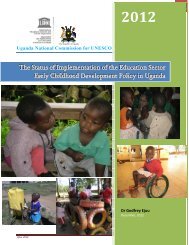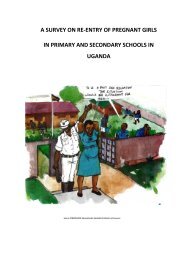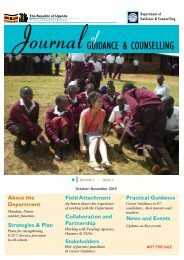Download Pdf - Ministry of Education and Sports
Download Pdf - Ministry of Education and Sports
Download Pdf - Ministry of Education and Sports
Create successful ePaper yourself
Turn your PDF publications into a flip-book with our unique Google optimized e-Paper software.
102<br />
Figure 4.33: Net Enrolment rate in the preprimary SubSector 20032012<br />
120.00%<br />
100.00%<br />
80.00%<br />
NER<br />
60.00%<br />
40.00%<br />
20.00%<br />
0.00%<br />
2003 2004 2005 2006 2007 2008 2009 2010 2011 2012 2015*<br />
Total 2.15% 1.47% 1.63% 1.6% 1.5% 3.9% 5.6% 6.1% 6.6% 7.1% 100%<br />
Male 2.09% 1.45% 1.63% 1.59% 1.5% 4% 5.5% 6.3% 7.2% 8.2% 100%<br />
Female 2.22% 1.49% 1.63% 1.51% 1.5% 3.9% 5.7% 6.2% 6.7% 7.2% 100%<br />
Source: EMIS 20032012<br />
Preschool Net enrolment rate has remained low over the years. In 2003 the NER was 2.15 translating<br />
into a gap <strong>of</strong> 97.9 percent. Despite improvement, from 2008 onwards, over 90 percent <strong>of</strong> the preschool<br />
going children do not access preschool. For instance, in 2012 for every 100 children <strong>of</strong> preschool<br />
going age only 7 were in school. If no affirmative action is taken now, by 2015 only 9 children<br />
out <strong>of</strong> every 100 preschool going children will be attending school. This implies that the targeted<br />
NER <strong>of</strong> 100 percent will not be met by 2015.<br />
4.5.2 Goal 2: Universal Primary <strong>Education</strong><br />
The target for goal 2 is to ensure that, by 2015, children everywhere, particularly the girls, children in<br />
difficult circumstances <strong>and</strong> those belonging to ethnic minorities, have access to & complete free &<br />
compulsory primary education. The past decade has seen tremendous progress in getting children <strong>of</strong><br />
primary school age into school with the Central, Western <strong>and</strong> Southern having the fastest pace <strong>of</strong><br />
progress.<br />
Since 2000, the education <strong>and</strong> sports sector has been tracking progress made towards the attainment<br />
<strong>of</strong> goal 2 through mainly three indicators; Gross Enrolment Ratio, Net Enrolment Ratio (NER)<br />
percentage share <strong>of</strong> girls to total enrolment, Proportion <strong>of</strong> pupils starting P.1 who reach P.5<strong>and</strong><br />
Primary completion rate 3 .<br />
4.5.2.1 Primary School Enrolment Trends<br />
Growth <strong>of</strong> enrolment in Ug<strong>and</strong>a has experienced a persistent increase since the introduction <strong>of</strong><br />
Universal Primary <strong>Education</strong> in 1997. In the first year (1997) <strong>of</strong> UPE, there were 5.3 million children<br />
accessing primary education in Ug<strong>and</strong>a. Years following the introduction <strong>of</strong> UPE were characterized<br />
with drastic enrolment growth for both boys <strong>and</strong> girls. Figure 4.34 below shows enrolment trends in<br />
the Primary SubSector from 2000 to 2012;<br />
Year<br />
3 Primary completion rate is defined as the total number <strong>of</strong> pupils registered for registered for the PLE, regardless <strong>of</strong> age, expressed as a<br />
percentage <strong>of</strong> the population at the <strong>of</strong>ficial primary graduation age.<br />
ESSAPR FY 2011/12 to inform the 19 th ESSR – OCTOBER 2012








